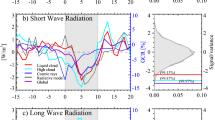Abstract
In their description of the solar radio emissions from the great sunspot of February 1946, Appleton and Hey1 pointed out that a number of sudden enhancements of intensity, observed at about 5 metres wave-length, occurred simultaneously with increases in D-layer ionization as indicated by fade-outs on long-distance radio-communication circuits. This increased ionization, which is believed to be due to enhanced solar ultra-violet radiations, strongly absorbs the radio communication waves (of the order of 20 metres wave-length) but does not produce any marked absorption of the solar radio emissions at wave-lengths of 5 metres or less.
This is a preview of subscription content, access via your institution
Access options
Subscribe to this journal
Receive 51 print issues and online access
$199.00 per year
only $3.90 per issue
Buy this article
- Purchase on Springer Link
- Instant access to full article PDF
Prices may be subject to local taxes which are calculated during checkout
Similar content being viewed by others
References
Appleton and Hey, Phil. Mag., 37, 73 (1946).
Jánsky, Proc. Inst. Rad. Eng., 20, 1920 (1932); 21, 1387 (1933); 23, 1158 (1935): 25, 1517 (1937).
Saha, Nature, 158, 599 (1946).
Martyn, Nature, 159, 26 (1947).
Author information
Authors and Affiliations
Rights and permissions
About this article
Cite this article
HEY, J., PARSONS, S. & PHILLIPS, J. Solar and Terrestrial Radio Disturbances. Nature 160, 371–372 (1947). https://doi.org/10.1038/160371a0
Issue Date:
DOI: https://doi.org/10.1038/160371a0
This article is cited by
-
Frequency Variation of the Intensity of Cosmic Radio Noise
Nature (1948)
-
Der Einflu� der Erdatmosph�re bei astronomischen Beobachtungen
Die Naturwissenschaften (1948)
Comments
By submitting a comment you agree to abide by our Terms and Community Guidelines. If you find something abusive or that does not comply with our terms or guidelines please flag it as inappropriate.



